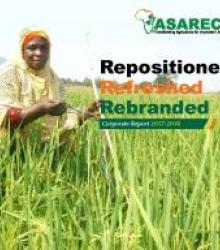| Title | Author | Full Text | Asbract |
|---|---|---|---|
| Agricultural Innovation Systems and Value Chains Development: A Training Manual | Joseph Methu, Julius Nyangaga, Amos Waweru and Doris Akishule | AIS VCD Training Manual for Web.pdf | his is one of a series of training modules developed following several workshops on agricultural innovation systems (AIS) and value chains development (VCD) organized for principle investigators of ASARECA programs in 2010 and 2011. The modules were compiled to assist in facilitating similar training that participant trainees may organize. The principle behind teaching and presenting the two concepts of innovation systems and VCD is based on the fact that they are strongly related, and there is opportunity for thinking and applying the two together in most agricultural programs. These modules are best presented in 2-hour sessions using a suggested 3, 4 or 5-day program. In the 4 or 5-day program, 1 day should be dedicated to a field activity, such as a visit to a value chain network or innovation system so that participants get hands-on experience of various aspects such as roles, contribution and benefits of the relationships in the innovation system, and participate in monitoring and evaluation. The 35-day training period is too short to cover essential details of understanding and operations of innovation and VCD. The most affected is VCD, which, on its own, should be taught in not less than 5 days. A well-developed VCD training program extends for at least 10 consecutive days (or stretches for a full 2 weeks). However, these sessions have been designed for program managers to expose them to basic information that can be used to design and manage programs. The training sessions therefore present introductory modules to various related concepts. It is expected that by the end of the 35-day course, trainees will have a basic understanding of the two concepts and how they can be presented in proposals, detailed strategies and action plans as well as what could go into performance tracking. In addition, at the end of each topic there is a Reference and Further Reading section that shows areas and topics that the trainees should make efforts to get for more information (knowledge). The full list of modules and suggested training program is shown in the following schedule. |
| Payment for environmental services: Laying the ground work | ASARECA | Between 2009-2011 ASARECA supported a consortium of five institutions in three countries, namely, the School of Environmental Studies (Moi University), Kenya Agricultural Research Institute (KARI), and VIRED International ÔÇô all of Kenya; University of Kinshasa & INERA of D. R. Congo; Nature Harness Initiatives and the Environmental Conservation Trust both of Uganda, to conduct research to develop methods for Valuation, Attribution and Compensation for Payments for Environmental Services (VAC-PES) in Eastern and Central Africa. The target research landscapes were the Mt. Elgon Region (Cross boundary between Uganda and Kenya) and the Albertine Rift (between Uganda and DRC). Many other institutions have carried out studies and undertaken PES related activities in other landscapes in Eastern and Central Africa, but the information on these activities occurs in a disjointed manner. The papers presented in this book are an attempt to pool some of this information into one volume. The papers cut across different aspects of Environmental Services (watershed management, carbon sequestration, and biodiversity management), as well as policy and institutional issues related to PES. It is envisaged that this publication will provide information necessary to spur PES programmess in the region. |
|
| ASARECA Operations Manual Vol.1 | ASARECA | ASARECA Operations Manual Vol.1_0.pdf | Grants Solicitation, Financial Management and Internal Audit |
| Administrative Policies and Procedures, and Procurement and Disposal Guidelines | ASARECA | ASARECA Operations Manual. Vol.2.pdf | The Association for Strengthening Agricultural Research in Eastern and Central Africa (ASARECA) is a sub-regional not-for-profit Association. It was formally established in 1994 by ten member States represented by their National Agricultural Research Institutes (NARIs) following the approval of the Framework for Action (FFA) for Agricultural Research in Eastern and Central Africa by the Special Programme for Africa Agricultural Research (SPAAR). The original ten member States included Burundi, represented by Institut des Sciences Agronomiques du Burundi (ISABU); Democratic Republic of Congo, represented by Institut National pour l’etude et la’ Recherche Agronomique (INERA); Eritrea, represented by the National Agricultural Research Institute (NARI); Ethiopia, represented by Ethioipian Institute of Agricultural Resaerch (EIAR); Madagascar, represented by Centre national de recherché appliqué au Development Rural (CERADERU/FOFIFA); Rwanda, represented by Institut des Sciences Agronomiques du Rwanda (ISAR); Sudan, represented by Agricultural Research Corporation (ARC);Tanzania, represented by Department of Research and Development (DRD); and Uganda, represented by the National Agricultural Research Organization (NARO). Subsequently, South Sudan joined ASARECA during the General Assembly convened in December 2011, while the Republic of the Congo (RoC) joined the Association in 2019, bringing the total membership to 12. |
Search
Manuals
Copyright © 2025. All rights reserved.
Designed By ASARECA


